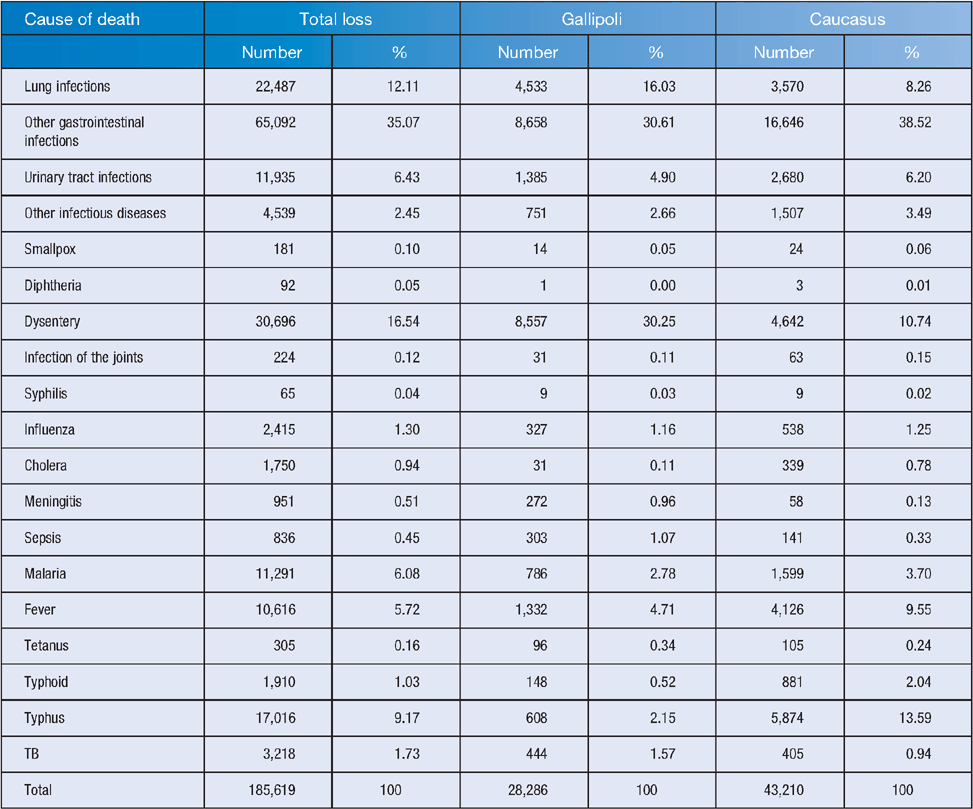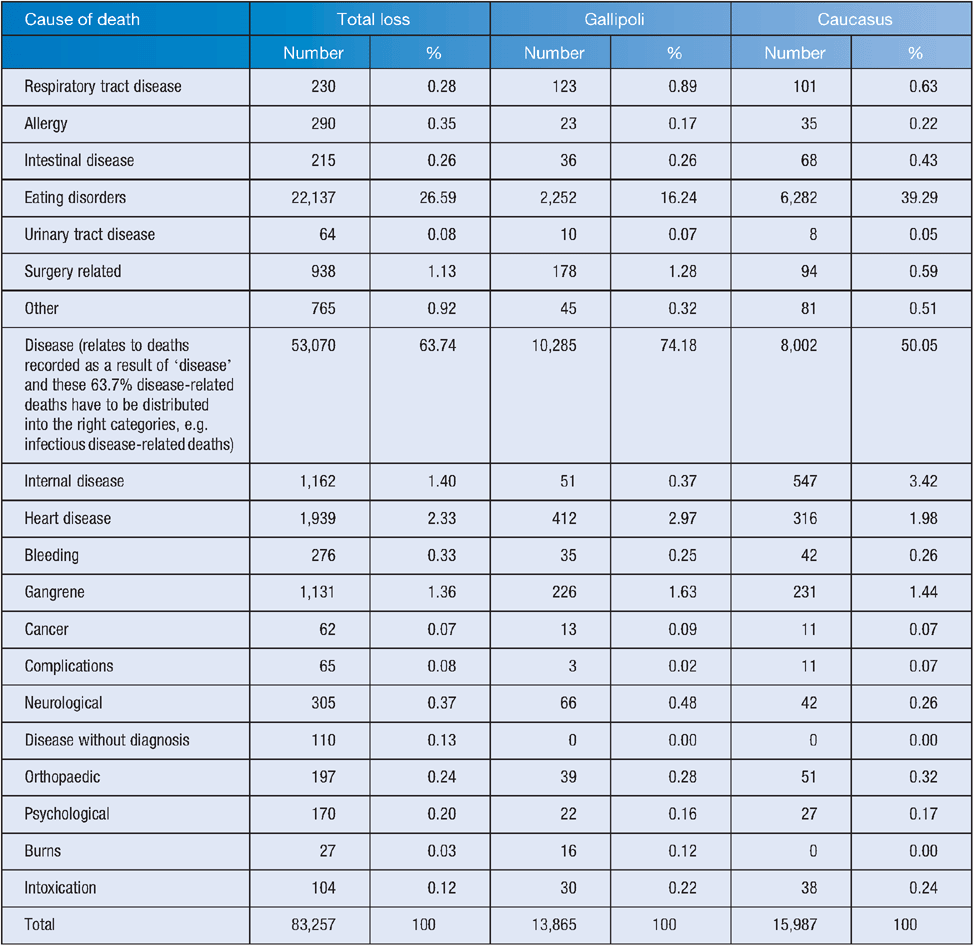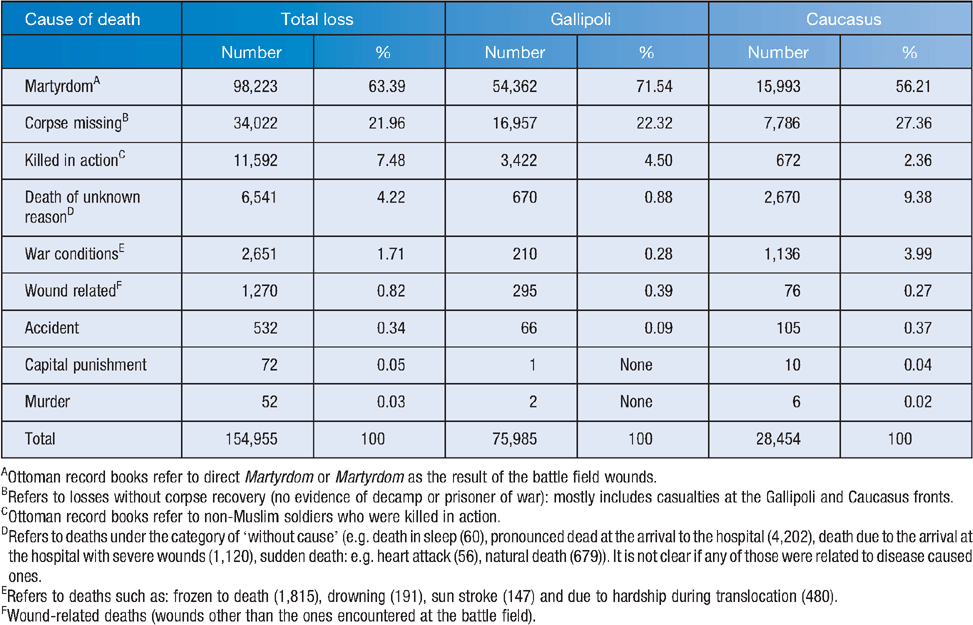Losses related to infectious diseases in the Turkish army during World War I
Sadık Emre Karakuş A and Ahmet C Başustaoğlu BA Turkish Ministry of Defence,
Archive Command
Ankara, Turkey
Email: sadik.karakus@msb.gov.tr
B Eastern Mediterranean University
Faculty of Pharmacy
Department of Microbiology
Famagusta, Turkish Republic of Northern Cyprus
Email: basustaoglu@gmail.com
Microbiology Australia 35(3) 144-147 https://doi.org/10.1071/MA14051
Published: 5 September 2014
The lengthy period that encompasses the Balkan War (8 October 1912 to 29 September 1913), followed by WWI (28 July 1914 to 30 October 1918) fought by the Ottoman Empire and the subsequent Turkish War of Independence initiated by the secret arrival of the great leader Mustafa Kemal (in the Republican era Atatürk) at the Black Sea town of Samsun on 19 May 1919 came to an end with the signing of the Mudanya Agreement on 11 October 1922 and formally terminated with the Lausanne Agreement on 24 July 1923. Turks bravely fought at different fronts over three different continents and by the end of a decade of war the losses amounted to 1,000,000 lives as well as 4,000,000 square meters of the Ottoman Land1.
Reasons for the failure of Ottoman Forces with around 3,000,000 conscripts at many fronts, and the signing of the ceasefire agreement at Moudros (The Armistice of Moudros, 30 October 1918) as the defeated party are still subject of much investigation and analysis for many historians and researchers, today. There have so far been political, military and economic explanations. However, none of these investigations included infectious diseases as a possible explanation for the heavy losses suffered by the soldiers throughout these wars. Detailed records and statistical data related to infectious diseases and their impact on the final decades of Ottoman military history have been so far unavailable. Similar to the allies, the Turkish side also started compiling records related to the losses and casualties immediately after WWI; however, records based on different sources compiled since 1919 are still far from representing the real cause of deaths. This fact is clearly presented in a book by Hikmet Özdemir2 who describes in detail the losses suffered by all parties.
The aims of present analysis can be grouped under two headings:
1. Aspects of military history
In this section, full details of 423,779 deaths during the WWI, dates and places of death will be communicated.
2. Aspects of medical history
In this section, the impact of infectious diseases on the army and civil population behind each front as well as the relationship between the war environment and emergence of infectious diseases will be discussed.
The investigation presented here has been carried out with the approval of the Turkish Ministry of Defence (MSB) as an evaluation of data generated by the MSB-Archives Division regarding war-related losses3. The causes of 423,779 deaths from written records were analysed (transcriptions from Ottoman into current Turkish language were carried out) and 587 different causes were entered into the system database. The aim of the Loss Documentation Project is to identify all combat deaths since the Crimean War (1853–1856). The major source of reference is an Ottoman collection of 67 hand-written registers of 400 pages in alphabetical order, with each page covering 25 records and different ink colours marking different causes of death (Figure 1). While it is estimated that the number of deaths will be above 700,000 once the Project is complete (the margin of error related to different causes of death will remain around ±2), Gallipoli and Caucasus fronts were selected to form case studies for comparative reasons.
Findings
A comparison of 423,779 deaths sorted in terms of causes at two major war fronts, Gallipoli and Caucasus respectively, is summarised in Table 1 and the details of the disease-related deaths are given in Tables 2 and 3.
(1) Out of the 423,779 deaths 43.8% (185,619) were caused by infectious diseases, 19.6% (83,257) were due to other disease-related causes and the remaining 36.5% (154,903) had other war-related causes.
(2) Interestingly, Ottoman Empire was the only country in WWI, which had an exceeding number of disease-related deaths over those combat related.
(3) Deaths at combat were recorded as Martyrdom (for Moslem Ottoman soldiers) and Killed in Action (for non-Moslem Ottoman soldiers) with a ratio of 25.9% (109,815). The percentage of deaths reaches a substantial 34.5% when undocumented deaths marked as ‘unidentified’ due to drowning, freezing and so on are also taken into consideration.
(4) The first three major causes of death due to infectious diseases appear to be other gastro-intestinal infections (35%), dysentery (16.5%) and respiratory tract infections (12.1%).
(5) In Gallipoli, deaths related to infectious diseases were identified as 23.9% (28,886), whereas in the Caucasus, it stood at 49.3% (43,210). Intense war conditions experienced in Gallipoli battlefields were the major cause of deaths ahead of infections.
(6) At Gallipoli, respiratory tract infections (16%) and dysentery (30.2%), whereas in the Caucasus region gastro-intestinal infections (38.5%) and typhus (13.5%) were the major causes of death.
(7) Other non-infectious diseases, which played a role in wartime deaths, were scurvy, malnutrition and anaemia constituting 30% of the deaths over other disease-related causes (Table 4).

|

|

|

|
Discussion
In WWI, one in every three soldiers in the Ottoman Army lost their lives due to malnutrition and disease. The whole picture related to the Balkan War, WWI and Turkish War of Independence (19 May 1919 to 24 July 1923) indicates 22.5% losses due to infectious diseases and 4.62% from other disease-related causes. In the chain of command, one fourth of the officers lost their lives due to an infectious disease. In the Balkan Wars and WWI, the number of infectious-disease related deaths was higher but this rate decreased during the Turkish War of Independence.
In his memoirs3 Prof. Dr Tevfik Sağlam (in the Ottoman era Tevfik Salim) describes the adverse conditions experienced during WWI:
That the armed forces succumb to infectious disease in such a short time shows how poor sanitary conditions have been. This situation is the result of malnutrition, lack of protection against severe weather and duty under extreme conditions. It is not possible for soldiers to survive prolonged malnutrition and low-calorie diet. Soldiers who lose weight every month can succumb even to flu and easily die within a few months. Skeletal statuses of the soldiers at arrival in hospitals are indicative of these facts and this condition of prolonged malnutrition will easily destroy the armed forces before they are hit by any disease. Improved conditions can only be achieved if regular and adequate food intake of the soldiers is ensured as well as preventative measures in public health. The major cause of these difficult conditions is the lack of senior officers and medical doctors who themselves have been struck by the disease.
The Ottomans entered WWI without any preparatory steps and preventative measures, hence the resulting miserable conditions. Medical aspects of the war were not perceived important when the war started. Evacuation routes for the sick and wounded were not planned; however, Turkish medical teams solely with their extraordinary efforts and self-sacrifice attended to most casualties as described in the memoirs of Military General and Medical Doctor Prof. Tevfik Sağlam. They even produced vaccines against typhoid fever, typhus, cholera and smallpox under primitive conditions in Anatolian towns (Sivas, Kayseri and Erzurum) and administered these not only to soldiers but also to the general public. They implemented public health measures and prevented greater disasters from happening, and these practices successfully reduced the percentages of death and disease from 1916 onwards4.
References
[1] Özey, R. (2000) Osmanlı Devleti’nin Hakimiyet Sahası, Osmanlı. Yeni Türkiye Yayınları, Ankara.[2] Özdemir, H. (2005) Salgın Hastalıklardan Ölümler 1914–1918. Türk Tarih Kurumu Yayınları, Ankara.
[3] Sağlam, T. (1941) Büyük Harpte 3. Orduda Sıhhi Hizmetleri. Askeri Matbaa.
[4] Başustaoğlu, A.C. et al. (2012) Balkan, Birinci Dünya ve Kurtuluş Savaşlarında Türk Ordusunun Mikrobiyolojik Etkenlere Bağlı Kayıpları. Conference presentation (35th Congress of the Turkish Society for Microbiology, 3–7 November), Kuşadası, Turkey.
Biographies
Prof. Ahmet C. Başustaoğlu (MD) is a graduate of Gülhane Military Medical Academy (GATA), Ankara. Following his graduation in 1985 he served at the Turkish Naval Forces for 2 years as a medical practitioner. From 1987 until 1990 he returned to GATA for his specialisation in Medical Microbiology. Following his specialisation in the field he served in the Turkish Army for two years and subsequently returned to academia as Associate professor in 1995. From1995 to 1996 he was in the USA for his sabbatical at the Duke University and on his return to Turkey he was appointed as full professor at GATA and serving as the Discipline Director at the Department of Microbiology. He has recently retired from the Turkish Armed Forces (2013) and took up a new academic position at Eastern Mediterranean University, Faculty of Pharmacy, Department of Microbiology, Famagusta, Turkish Republic of Northern Cyprus. He has over 150 peer-reviewed publications. He has received awards on his translation work from English to Turkish for Manual of Clinical Microbiology (2009), Medical Microbiology (2011) and Clinical Microbiology Procedures Handbook (2014) from the Turkish Academy of Sciences.
Mr Sadık Emre Karakuş (BA, MA) is a graduate of Fırat University, Faculty of Science and Arts, Department of History. He completed his post-graduate work (MA) on the assessment and translation (from Ottoman to Turkish) of the Edirne Sharia Records No: 270 related to the years 1802 and 1803. He is currently a PhD candidate at the same University as well as working at the Turkish Ministry of Defence, Archive Command in Ankara, Turkey as an expert in History. He has publications related to History of Ottoman cities, Turkish Military History and Medical History. He has expertise in the Ottoman language and script which is invaluable for translation of records belonging to Ottoman the era (pre-Republican era of Turkey).



